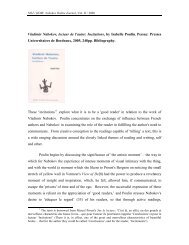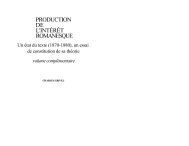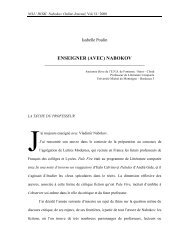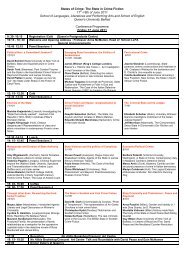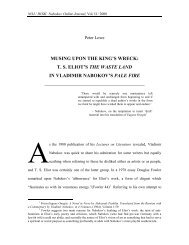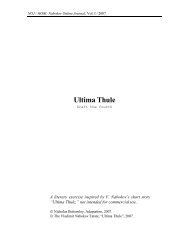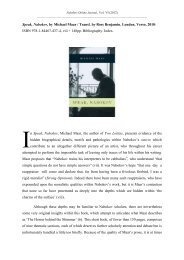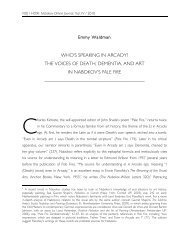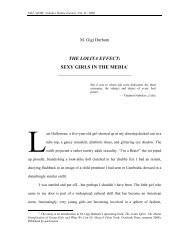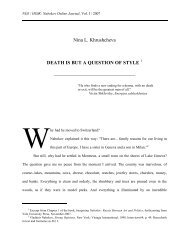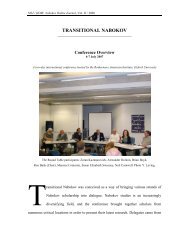domesticated translation: the case of nabokov's translation of alice's
domesticated translation: the case of nabokov's translation of alice's
domesticated translation: the case of nabokov's translation of alice's
You also want an ePaper? Increase the reach of your titles
YUMPU automatically turns print PDFs into web optimized ePapers that Google loves.
N. Vid. “Domesticated Translation”<br />
and culture <strong>of</strong> <strong>the</strong> target text) and foreignized 2 (emphasis on <strong>the</strong> language and culture <strong>of</strong><br />
<strong>the</strong> source text) <strong>translation</strong> strategies.<br />
Venuti defines <strong>domesticated</strong> <strong>translation</strong> as “an ethnocentric reduction <strong>of</strong> <strong>the</strong><br />
foreign text to target language cultural values, bringing <strong>the</strong> author back home.” In this<br />
<strong>case</strong> translator should erase every shred <strong>of</strong> foreignness and create a familiarized and<br />
immediately recognizable text, adjusted to <strong>the</strong> target text’s linguistic and cultural<br />
dimensions (1995: 20). On <strong>the</strong> contrary, followers <strong>of</strong> <strong>the</strong> foreignized method see <strong>the</strong><br />
source text as <strong>the</strong> only objective reality <strong>of</strong> a literary work. Their primary aim is to transfer<br />
<strong>the</strong> original idea <strong>of</strong> <strong>the</strong> text as exactly as possible – without any additional interpretations,<br />
explanations or adaptations. Using this method, <strong>the</strong> translator is expected to preserve <strong>the</strong><br />
foreign identity <strong>of</strong> <strong>the</strong> source text, i.e. to keep linguistic and cultural differences in <strong>the</strong><br />
<strong>translation</strong>. Foreignized <strong>translation</strong> gives readers more information about <strong>the</strong> foreign<br />
culture but tends to increase <strong>the</strong> difficulty <strong>of</strong> understanding <strong>the</strong> text.<br />
Translators who are disposed to <strong>the</strong> <strong>domesticated</strong> method proclaim that <strong>the</strong><br />
essential component <strong>of</strong> any literary work is not its “technical” side, but something<br />
invisible and <strong>of</strong>ten called <strong>the</strong> “spirit” <strong>of</strong> <strong>the</strong> original. This “spirit” has to be successfully<br />
transferred into <strong>the</strong> target culture. According to Nida Eugene, domestication also permits<br />
adjustments to “special literary forms,” “semantically exocentric expressions” or<br />
“intraorganismic meanings” (1964: 170). Naturalness, as a key requirement in this type <strong>of</strong><br />
<strong>translation</strong>, should be raised to such a degree that it “bear[s] no obvious trace <strong>of</strong> foreign<br />
origin” (1964: 167).<br />
2 Domesticated <strong>translation</strong> is also described as target language (TL) or “reader-to-author”<br />
approach and foreignized, as source language (SL) or “author-to-reader.”



